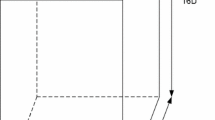Abstract
In most of partially averaged Navier-Stokes (PANS) methods, the Reynolds stress is solved by a linear hypothesis isotropic model. They could not capture all kinds of vortexes in tubomachineries. In this paper, a PANS model is modified from the RNG k - ε turbulence model and is used to investigate the influence of the nonlinear shear stress on the simulation of the high pressure gradient flows and the large curvature flows. Comparisons are made between the result obtained by using the PANS model modified from the RNG k - ε model and that obtained by using the nonlinear PANS methods. The flow past a curved rectangular duct is calculated by using the PANS methods. The obtained nonlinear shear stress agrees well with the experimental results, especially in the high pressure gradient region. The calculation results show that the nonlinear PANS methods are more reliable than the linear PANS methods for the high pressure gradient flows, the large curvature flows, and they can be used to capture complex vortexes in a turbomachinary.
Similar content being viewed by others
References
Craft T. J., Launder B. E. On the spreading mechanism of the three-dimensional turbulent wall jet [J]. Journal of Fluid Mechanics, 2001, 435: 305–326.
Lübcke H. M., Rung T., Thiele F. Prediction of the spreading mechanism of 3D turbulent wall jets with explicit Reynolds-stress closure [J]. International Journal of Heat and Fluid Flow, 2003, 24(4): 434–443.
Durbin P. Separated flow computations with the k - ε - ν2 model [J]. AIAA Journal, 1995, 33(4): 659–664.
Laurence D. R., Uribe J. C., Utyuzhnikov S. V. A robust formulation of the v2-f model [J]. Flow Turbulence and Combustion, 2005, 73(3): 169–185.
Popovac M., Hanjalic K. Compound wall treatment for RANS computation of complex turbulent flows and heat transfer [J]. Flow Turbulence and Combustion, 2007, 78(2): 177–202.
Tucker P. G. Trends in turbomachinery turbulence treatments [J]. Progress in Aerospace Sciences, 2013, 63(6): 1–32.
Girimaji S. S., Jeong E., Srinivasan R. Partially averaged Navier-Stokes method for turbulence: Fixed point analysis and comparison with unsteady partially averaged Navier-Stokes [J]. Journal of Applied Mechanics, 2006, 73(3): 422–429.
Girimaji S. S. Partially-averaged Navier-Stokes model for turbulence: A Reynolds-averaged Navier-Stokes to direct numerical simulation bridging method [J]. Journal of Applied Mechanics, 2006, 73(3): 413–421.
Jeong E., Girimaji S. S. Partially averaged Navier-Stokes (PANS) method for turbulence simulations?Flow past a square cylinder [J]. Journal of Fluids Engineering, 2010, 132(12): 121203.
Huang B., Wang G. Y. Partially averaged Navier-Stokes method for time-dependent turbulent cavitating flows [J]. Journal of Hydrodynamics, 2011, 23(1): 26–33.
Luo X. W., Ji B., Tsujimoto Y. A review of cavitation in hydraulic machinery [J]. Journal of Hydrodynamics, 2016, 28(3): 335–358.
Ji B., Luo X. W., Wu Y. L. et al. Partially-averaged Navier-Stokes method with modified k - ε model for cavitating flow around a marine propeller in a non-uniform wake [J]. International Journal of Heat and Mass Transfer, 2012, 55(23–24): 6582–6588.
Ji B., Luo X., Wu Y. et al. Numerical analysis of unsteady cavitating turbulent flow and shedding horse-shoe vortex structure around a twisted hydrofoil [J]. International Journal of Multiphase Flow, 2013, 51(5): 33–43.
Krajnovic S., Ringqvist P., Basara B. Comparison of partially averaged Navier-Stokes and large-eddy simulations of the flow around a cuboid influenced by crosswind [J]. Journal of Fluids Engineering, 2012, 134(10): 101202.
Hu C. L., Wang G. Y., Wang Z. Y. Partially averaged Navier-Stokes method based on k - ε model for simulating unsteady cavitating flows [J]. Materials Science and Engineering, 2015, 72(2): 022007.
Reyes D. A. Partially averaged Navier-Stokes turbulence modeling: Investigation of computational and physical closure issues in flow past a circular cylinder [D]. Master Thesis, College Station, USA: Texas A&M University, 2006.
Basara B., Krajnovic S., Girimaji S. et al. Near-wall formulation of the partially averaged Navier-Stokes turbulence model [J]. AIAA Journal, 2011, 49(12): 2627–2636.
Davidson L., Peng S. H. Embedded large-eddy simulation using the partially averaged Navier-Stokes model [J]. AIAA Journal, 2013, 51(5): 1066–1079.
Liu J., Zuo Z., Wu Y. et al. A nonlinear partially-averaged Navier-Stokes model for turbulence [J]. Computers and Fluids, 2014,102(10): 32–40.
Kim W. J., Patel V. C. An experimental study of boundary layer flow in a curved rectangular duct [C]. Proceedings of the ASME Fluids Engineering Conference. Washington DC, USA, 1993.
Author information
Authors and Affiliations
Corresponding author
Additional information
Project supported by the National Natural Science Foundation of China (Grant Nos. 51406010, 51479166).
Biography: Jin-tao Liu (1986-), Male, Ph. D., Senior Engineer
Rights and permissions
About this article
Cite this article
Liu, Jt., Guo, Pc., Chen, Tj. et al. The influence of nonlinear shear stress on partially averaged Navier-Stokes (PANS) method. J Hydrodyn 29, 479–484 (2017). https://doi.org/10.1016/S1001-6058(16)60759-X
Received:
Revised:
Published:
Issue Date:
DOI: https://doi.org/10.1016/S1001-6058(16)60759-X



